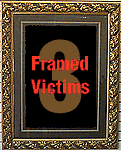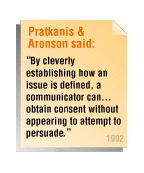
Framing II
Framing III
Framing IV
Framing V
Framing VI
Framing VII
Framing VIII
 Three Framed Victims
Three Framed Victims
 Three Framed Victims
Three Framed Victims  |
A college undergraduate who has recently moved into his own apartment, Franklin is wrestling with a decision: he is considering whether or not to purchase a VCR with his limited funds. He now stands before a display of VCRs at the local electronics store, considering the purchase. He thinks, "With a VCR, I can watch high-quality movies instead of the trash on network TV. And, the selection of movies on video is much larger than what's on TV. Plus, movies don't have ads!" Armed with three unassailable reasons, Franklin carries his prize to the cashier's counter. |
 |
Several blocks away, an encyclopedia salesman is talking to two young parents. He is well into his routine, and has already gotten them to admit that a quality education is of utmost importance to their children's future. He approaches the topic of price with great skill. "Although this investment may seem substantial at first glance," he admits, "with our extended payment plan, this set of encyclopedias will cost you less than 40 cents a day. Why, that's less than a can of soda! Wouldn't you say your children's education is worth more than a daily can of soda?" Having never thought of it in just that way, the young couple decide to purchase the set. |
Franklin, Lisa, and the young parents are the latest casualties
of the insidious framing device. As subtle as it is powerful,
the frame allows a communicator to manipulate choice alternatives
in order to influence thinking processes and obtain consent--without
ever appearing to attempt to persuade. The target of influence
is seldom aware that a particular response has been induced.
Franklin was the victim of his own reframe, the least
detectable and perhaps most powerful type of frame. Although
he entered the store with the frame of [VCR vs. no VCR], he allowed
the frame to slip onto an entirely different topic: [TV vs. Cinema].
Once the decision was reframed, Franklin was unable to generate
any reasons for not buying . . . cinema, which is what Franklin
really purchased. Franklin might have reframed the purchase
decision in other ways, too. He could have considered [VCR vs.
new computer], which might have led him to the computer section.
And had Franklin reframed the decision as [mindless entertainment
vs. productivity] he might have sped out of the store as he hurried
home to get busy with something really important. But once Franklin
allowed the decision to become one between [TV vs. cinema], the
decision was foregone. After all, who in his right mind could
argue that TV is better than cinema? 
Lisa is the victim of a focus frame. She has been led
to focus on the leanness, rather than the fatness, of her burger.
Would it have made a difference if Lisa had been told her burger
was 25% fat? You bet it would! In fact, researchers Levin &
Gaeth (1988) conducted a study using just this frame manipulation.
The researchers gave identical samples of ground burger to two
groups of tasters in their experiment. The only difference between
them was that one group was told the beef was 75% lean, and the
second group told it was 25% fat. Those that had been told it
was 75% lean rated the beef as significantly more lean, of higher
quality, more greaseless, and better tasting than "ordinary"
hamburger. Those that had been told it was 25% fat rated the
burger as more fatty, lower quality, and more greasy than regular
burger. Pity poor Lisa! Framed, by her waitress, into gaining
rather than losing weight!
Finally, the young couple fell victim to the contrast frame.
The salesman craftily shifted the focus of decision away from
the amount the young family could afford to spend. Instead, he
focused attention onto the mundaneness and unimportance of a
can of soda. Using it as a reference point, he then compared
it to the value of . . . not his encyclopedia set, but . . .
successfully educated children. He substituted associations for
the actual item. I think you will agree: given the frame [can
of soda vs. children's education], education will win every time.
And out came the checkbook.
These are three of several types of frames that I've identified.
But the important questions "What is a frame?" and
"How does a frame work?" remain unanswered. Please
continue . . .
www.workingpsychology.com
All rights reserved.

